I started my career in corporate America as a systems analyst for a computer company. There was a high value placed on efficiency in the work environment. When I moved over to education I found lots of opportunities to make my classroom run as smoothly as possible. It almost became a game to me. This post is a collection of my top tips for running an efficient science classroom.

Downtime is a Recipe for Disaster
We all know that any kind of downtime in class is an opening for students to make poor decisions. Proper planning can eliminate many of the discipline issues you might have in your classroom. I stole this first tip from a veteran teacher who seemed to always have a good flow in his classroom. His belief was that downtime, even for 30 seconds, was a recipe for disaster.
What he would do was set out all of the necessary papers for the entire day in the middle of the student’s lab tables in large stacks. This got rid of several problems. First, he didn’t need to dedicate time to passing out papers. It doesn’t sound like much, but if you had to pass out 3 handouts to each class over 6 or 7 periods, the amount of downtime adds up and problems can occur.

I tried to improve on his system by simply leaving the papers on a desk near the front door, but middle schoolers, as they often do, foiled my plan. Some of them wouldn’t pick them up. Other students would ask which ones they needed. Yet others would congregate around stacks and end up pushing and shoving each other because that’s what middle schoolers do.
The most effective method I found was to stack the papers for the entire day at the center of their lab tables and have them grab them when necessary. At the end of the class I would ask them to stack the blanks back up and make them look nice for the next class.
This saved about 5-10 minutes a day and countless discipline issues were avoided.
Science Journals Can Be Your Friend or Foe
Let’s move on to science journals. They are the centerpiece of the science classroom and can cause a ton of headaches if you don’t have a process in place for how to handle the distribution or storage of them.
In my classroom I made the students keep their journals in class unless they had a test the next day. I got sick and tired of students losing their journals or not bringing them to class. I know some of you are thinking, “But how are they going to be able to study during the week?” Really? Really? I don’t know what kind of students you have in your class, but mine weren’t studying content the week before a test. Heck, most of them didn’t even study the night before the test.
Now, I suppose it’s not fair to to say that about every student, but the students who were going to lose their journals or not bring them to class, were the same ones that weren’t studying. If someone asked to take it home I always obliged. This didn’t happen very often though. I’ve tried it both ways, and keeping them in class was a far superior solution for me.
I was fortunate enough to have large cabinets where each class had their own shelf to store their journals, but I’ve also seen journals stored spine side up in those large milk crates. Looking back I actually wish I would have done the milk crate because the cabinets became a source of stress when every student is trying to get their journal at once.
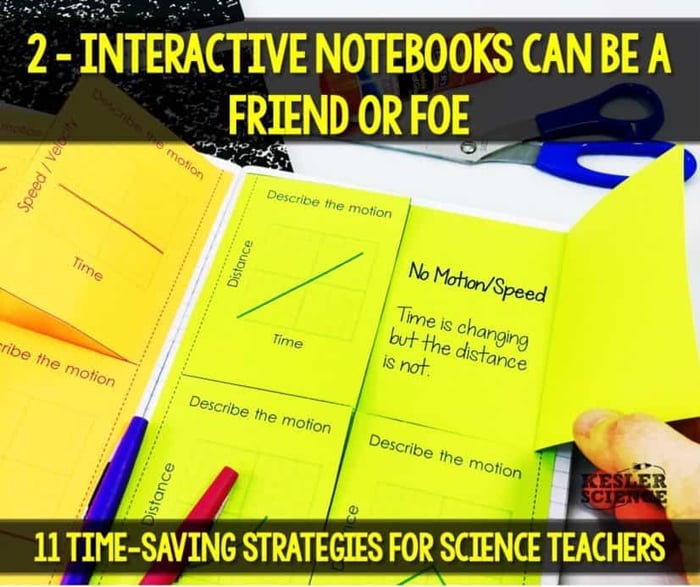
If you have lab tables I would suggest ‘hiring’ someone at the beginning of the year to be the supply manager at each table or group. This student is going to be responsible for grabbing the journals and supplies for the group each day. When students are picking this person have one of the criteria be that the student is usually early to class. This will allow them to gather supplies and have everyone be seated right at the bell.
I would also suggest using the same spot in your classroom all year long to communicate which supplies the students needed for the day. You could even have a sign that’s green on one side if journals are needed and red on the other side if they don’t need them.
At the end of the class the supply manager will collect the journals, put them together, and put them back in the crate.
If you want to take this strategy to the next-level you could use desk towers to keep students all in the same area. You could do so much with these organizational towers. Each period could have their own space for journals and you could use an extra drawer for supplies like glue, scissors, etc. I never set my class up this way, but wish I would have known this strategy while I was in the class.
The key to this whole process is consistency. Develop a plan that works for you and do it every single day. Students will love the structure and you will love the time saved.
Be Fashionably Late to Happy Hour
This next one will relieve a lot of the stress you may not even know you have. During my first month of teaching one of my AP’s stopped by my room dropped this little nugget on me. I did it throughout my time in the classroom and never regretted it.
On Friday afternoon stay in your classroom and prepare it for Monday morning. I know I know…the math department is hosting a happy hour and you want to get there ASAP, but here’s why this tip is so valuable.

When we leave unprepared for the next day it actually impacts your entire weekend. On Friday night the last thing you may be thinking about is Monday morning, but on Sat. you start to thinking about how tomorrow you need to finish up that PowerPoint for Monday morning. It’s just a thought at this point, but it’s an unnecessary one. Now Sunday rolls around and you’ve either got to finish what you need to do for Monday morning or make the decision to get there REALLY early on Monday and do it then. Sunday night you end up sleeping like crap because you’re worried about having enough time to get up and get to school so you can make those copies before the ELA teachers take over the copier. I probably just described many of you. It's OK. You're not alone!
My suggestion is to take the extra few minutes necessary to fully prepare for Monday morning. Write your objectives on the board, load up your lessons, setup your lab stations, set the copies out on the desks, and clean out your inbox. Monday morning you will walk in and be stress free. That's called WINNING!
If you do this consistently you will find yourself much less stressed throughout the year. You’ll find that you enjoy your weekend more and your mood will be improved during the work week. The math team will still be at happy hour 30 minutes later. It’s not cool to show up to the party too early anyway.
Failure to Plan is Planning to Fail
Let’s chat about lesson planning for few minutes. I’m a huge proponent of batch processing similar items and lesson planning is one of those items where this makes a lot of sense.
In my experience your prep period typically gets booked with other items like parent meetings, special ed meetings, committee prep activities, and after school tutorials. You may have a day or two to actually use it for lesson prep. Take advantage of that time.
However, what has worked for me is to set aside one day a week where I knew I was going to stay a little later and plan the entire next week’s lesson. I found that once the school is clear of students I was able to focus a lot better on the task at hand.

If your fortunate enough to plan with a team then it’s nice if you can all commit to a certain planning day each week and get it all done. I’ve been on teams before that wanted to meet 3-4 times a week for planning and in my opinion this isn’t necessary. It causes stress because you always seem to have this looming meeting where very little is accomplished.
I like to start any planning session reviewing the objective and then immediately writing or reviewing the assessment at the end of the lesson you're going to be teaching. You will find that your lesson is much better aligned with the objective if you start with the assessment. What do they need to know? How can you get the students to that point?
From there I like to write out a skeleton plan for the week. If you’re using the 5E model then this is really easy to do. This day is the exploration, that day is the explanation, etc. Afterwards you can decide all the materials you will need for each of the different activities. This is a great time to submit all your copies for the next week, find or purchase any supplies you needs, or create any resources like ppt’s or demonstrations. Again, if you’re on a team then split up the work.
The teaching years that were the least stressful for me were the ones which were planned out the best. Worrying about copies the day of the lesson or finding a video that correlates with your lesson that morning will send you into the asylum faster than you can say "when does summer start?!"
Shift Your Mindset to Rely on Students
This next strategy isn’t specific to one task, but it more of a mindset shift you can make which will make your life so much easier.
For every single task you do relating to the course of the school day I’d like you to ask yourself, “Can a volunteer student do this task for me?” As you put this into practice you will find that many of the day to day tasks you do can be done by students.

Here’s a quick list of activities I came up with that you probably do yourself that students could do for you.
- Collecting papers
- Delivering items to the office
- Cutting out activities
- Prepping work for absent students
- Answering questions that students may have
- Picking up things off the network printer
- Organizing shelves, tables, INB buckets
- Setting out papers for the next day
- Writing objectives on the board
- Filling glue bottles
- Setting up lab stations
- Walking around with the trash can
You won’t have to force students to do these tasks either. Many of them will want to do them. Think about all the time saved when you become more of a delegator rather than a do-it-your-selfer.
Another huge benefit is the relationship building that happens when students are working with you to accomplish a goal. I can’t tell you how many tough relationships I’ve been able to turn around simply by allowing students to help me during class or after school.
It’s going to take some practice if you’re not used to doing this already, but once you start the habit of asking “Can a volunteer student do this task for me?” You will eventually find yourself asking this question dozens of times a day.
Is He Going to Call on Me?!
This next tip is more of a classroom management tip, but a well managed classroom is an efficient classroom.
When you are formatively assessing student work I encourage you to use randomness. What this means is that you want to constantly keep your students on their toes when evaluating them either orally or written. It’s so easy to call on that one kid who knows the answer to all of the questions, but that doesn’t encourage growth in the other students, and in fact it causes them to tune out if they know they aren’t going to be called on.
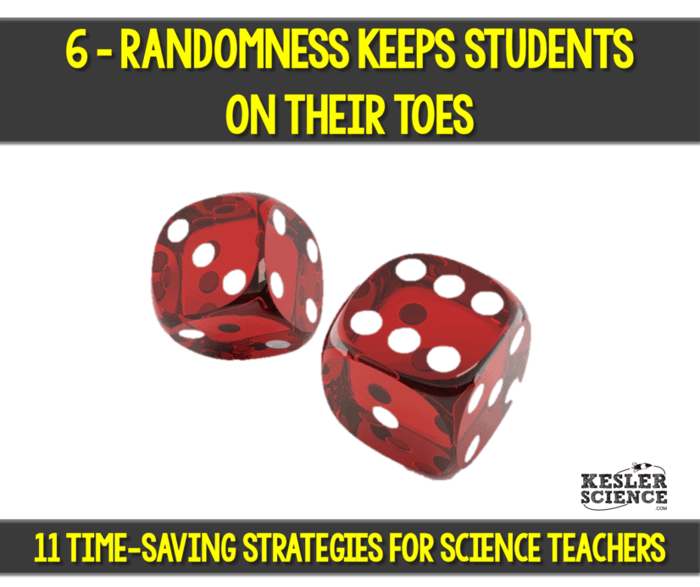
You could use a method like popsicle sticks in an cup or grab an app that randomly chooses students to answer questions. It becomes a game to them. I know from my own firsthand experience of being a student in a class that uses randomness that I paid attention a lot more. I used to have this English teacher that would close his eyes and pick a name of a chart. Terrifying!
If you want to supercharge this strategy, then I would suggest using the AB strategy coupled with randomness. At the beginning of the year you have students partner up and the person closest to the door is partner A and the other one partner B. Each time you ask a question you can say I want you to talk with your AB partner and come up with an answer. This gets every student talking. When you’re ready to fish for an answer then you can use a tool that allows you to inject randomness into the equation and select a group to answer. When everyone is forced to think about the question, the entire class wins.
Take a look at this chart.
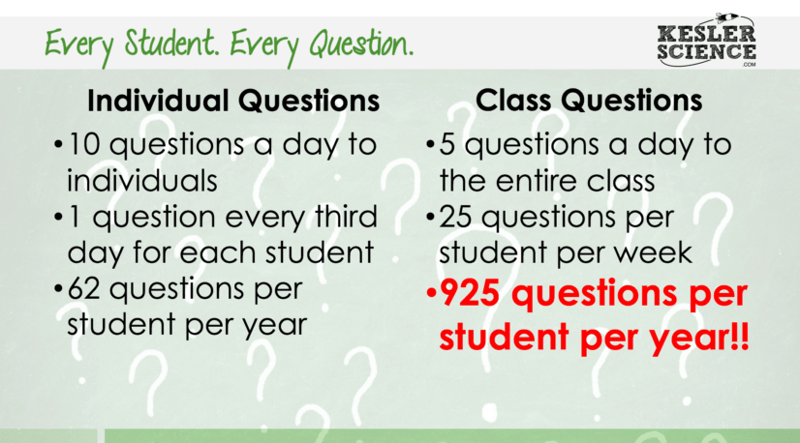
Which class is smarter? Which class would you want your kid in?
Grading Doesn't Have to be a Chore
Let’s jump over to grading for a few minutes. I’m going to say this up front. Grading was not fun for me as a teacher. After I started using the next couple of strategies my long nights of grading disappeared.
First up is the trade and grade. I’m sure everyone has used this at some point. I used this strategy all the time. As long as it wasn’t a major assessment I had no problems having students trade papers to leverage the power as a group and grade for me.

But what about the kids who cheat? I suppose it could happen from time to time, and that’s a conversation that needs to happen with those individuals. You should probably know where everyone stands in your classroom based on assessments. If you have someone consistently failing tests, but turns in A daily work, then you might to make sure that student isn’t up to any tricks.
If your class is anything like mine were then you probably never look forward to calling out the grading scale. You know you’re going to get questions like, “What did you say for 5 missed?” “How many for 7 missed?” This seems like a trivial thing, but you don’t have to burden yourself with these unnecessary questions. Pass the grading scale to a responsible student and have them read it off instead. Allow them to field the questions for you while you transition into the next thing.
On the Spot Grading
We’re going to stick with the grading theme for my next strategy. I call this one on the spot grading. If you have to grade the assignment because it’s a major assessment, or something that requires your feedback, then I would suggest using this strategy.
I used to setup a grading station right at my desk. When students would finish the assignment they could bring their work up and check it right there with me. For a scantron assessment I would make a key on one of those clear sheet protectors and students could slide their scantron in to quickly determine how many they missed. I would have them use the test to write down the ones they missed and then collect their scantron so they couldn’t make any changes. At this point they could take the test back to their desk and re-work those problems they missed. You can choose to give partial credit, or if you don’t like that option, give them a daily grade for their re-works.

Not only are they able to immediately get feedback on their performance, but you won’t have to use extra time for re-works.
I would also have my gradebook up and enter the grades as they came in. This saved me from having to do it later. There will always be students who work up to the bell. I used the first 15 minutes of the next class to finish up with the grading from the previous class.
At the end of the day you should be nearly complete with your grading and you haven’t even run the scantrons yet! The next day you can go over the top missed questions and get on with the next lesson.
Batch Process Your Similar Tasks
We talked about batch processing similar tasks before. I want to give you some other ideas on where you could use batch processing to make your life a lot easier.
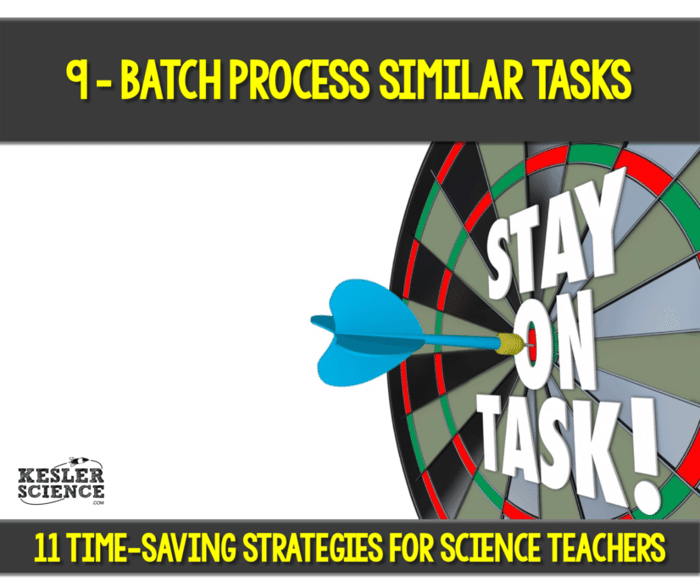
Here are some tasks that could be easily batch processed. Remember, the point of batch processing is so that you can keep focused on the task until completion rather then have small tasks lingering out there and causing stress and unnecessary items on your to do list.
- Parent phone calls.
- Communication to parents – use a tool like Remind (formerly remind 101)
- Parent meetings - If possible schedule these on the same day to get batch process them. I never had that many parent meetings in junior high, but you may.
- ARD’s or special ed meetings – these may be out of your control, but it may be possible to ask the special ed coordinator to schedule those meetings on one or two days of the week. It’s really a pain if you have to spend your planning periods day after day in an ARD. It never hurts to ask.
- Digital Lesson Plans – No need to re-invent the wheel every year when you can pick and choose from your lesson plan last year.
- Absentee Work – Keep folders for each period and put the absent students work into it the day they are absent. When they return direct them to the folder. If it’s a lab they need to makeup after school then leave a tutorial slip in the folder for them.
If You Don't Prioritize Your Time, Someone Will Prioritize It For You
I spend a lot of time reading and studying about time management. One of the recurring things that I see and hear over and over is this. If you don’t prioritize your time someone else is going prioritize it for you.
In my personal life I like to start the day off with 2-3 things that HAVE to get accomplished that day. Today the only thing on my must do list is to write this blog post and share it with the world. Everything else is closed on my desktop and my phone has been in airplane mode since this morning. At the end of the day I’m going to feel far more accomplished if I complete this one task than if I had a list of 25 things on my to do list but only got to 15 of them. Those 10 extra things hanging over my head are going to cause unnecessary stress.
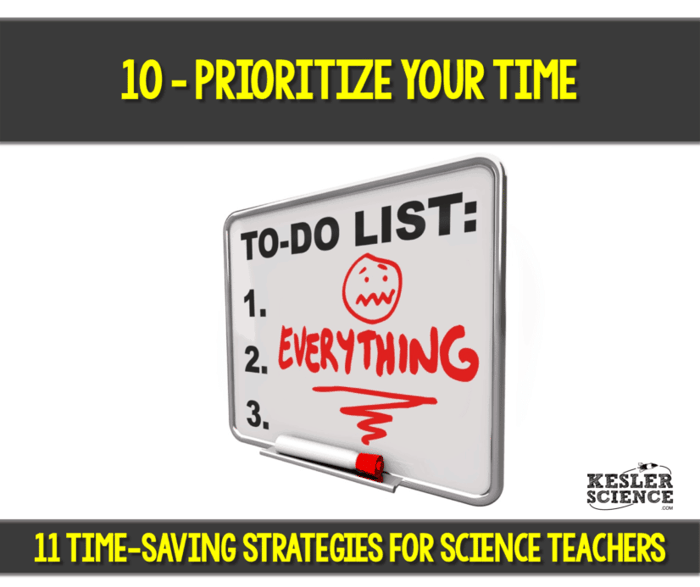
It does take some practice, but you can use this same strategy with school. Of course little fires will present themselves along the way but choosing to work on your priority items first will allow you to feel more accomplished than answering emails the second they hit your inbox.
Tim Ferriss, author of the 4-hour work week, says that you shouldn’t even open your email until around noon because you will lose focus of your own agenda and begin working on someone else's. Give it a try. My bet is you will get more accomplished in less time.
I Wish I Could Clone Myself
This last one is my absolute favorite of all the strategies I talked about. You know how you’re always thinking, “Gosh, if I just had an extra body in the room this would go so much more smoothly.” You CAN actually be in two places at the same time if you record your lessons.
Back in the day this was a lot more difficult that it is now. There are so many screen capture programs out there now that it’s a crime if you don’t give this a shot for your next lesson.
You can use programs like Jing, CamStudio, SmartNotebook Recorder, Screencast-o-matic. Your campus technologist may even have software like Camtasia that will allow you to do this as well.

The way I handled it for my lessons was to record the lesson prior to the first class getting there. I really only did this when I was in the explanation piece of the 5E model. For example, I would record myself going through a powerpoint of a particular topic. One cool thing about recording your lesson is that you are communicating the exact message you want your students to hear, and better yet...it’s succinct.
I purchased one of those remotes that I could use to control the playback of the video from across the room. I then stopped the video when it came time to do an activity that required some sort of feedback. This also broke up the monotony of listening to me speak the entire time. No one wants to hear that.
You can also use these recordings to post online for absent students or as a resource for students/parents to go back to.
Another bonus is that you can now be a classroom facilitator while teaching at the same time. Discipline issues will go down. Attention spans will increase. And at the end of the day you will be soooooo much happier!
I really really really encourage you to try this for one of your lessons. I’ll bet you’ll be emailing me about how great your day was!
Work-Life Balance Happens Because of You
I love this saying. Work-life balance isn’t something that happens to you. It happens because of you.
Download Over $100 in FREE Resources
For Middle School Science
Simply create a login below and gain immediate access to a selection of our Kesler Science product line worth $100 - for FREE. There's a full version of every product type! You'll also join tens of thousands of middle school science teachers who receive timely tips and strategies straight to their inbox.




